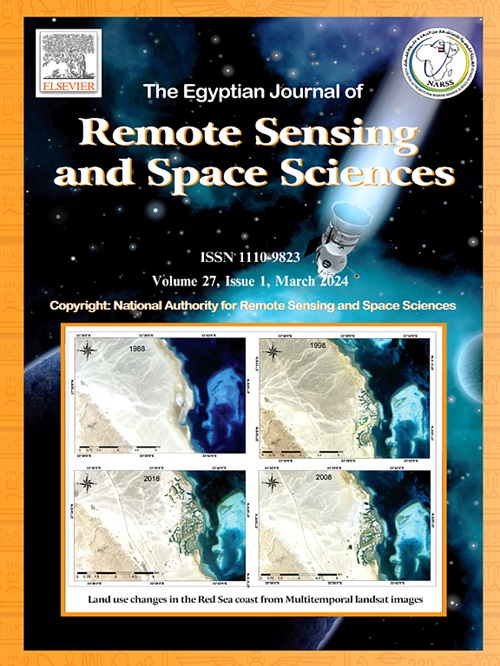使用高光谱图像进行土地利用和土地覆盖分类的人工智能光谱空间特征提取技术-综述
IF 4.1
3区 地球科学
Q2 ENVIRONMENTAL SCIENCES
Egyptian Journal of Remote Sensing and Space Sciences
Pub Date : 2025-07-18
DOI:10.1016/j.ejrs.2025.06.004
引用次数: 0
摘要
机器学习和深度学习等人工智能技术的发展促进了高光谱图像处理,可用于开发各种遥感应用,如土地利用和土地覆盖变化检测(LULC)分类、农业作物营养成分评估和健康状况评估。然而,高光谱成像在遥感和地球观测应用中经常被用于识别环境变化。高光谱图像分类的关键任务之一是特征提取。本文综述了近年来用于LULC的高光谱图像特征提取技术。本研究旨在确定开放的问题、研究挑战和未来的方向,这将有助于研究人员开发有效的特征提取技术,以更好地进行LULC高光谱图像分类。从总体精度、平均精度和kappa系数三个方面分析了目前最先进的高光谱图像特征提取技术在基准数据集(即Indian Pines、Pavia和Salinas数据集)中的性能。通过分析,我们发现在所有的基准数据集中,与其他竞争框架相比,具有光谱-空间集成的2D + 3D CNN框架不仅提取了综合特征,而且在计算复杂度较低的情况下提高了分类精度。二维cnn和三维cnn都用于从多光谱波段的数据中提取特征和模式,每种架构都有其优势和挑战。2D cnn更常见,计算效率更高,而3D cnn更直接地捕获空间-光谱相关性。本文章由计算机程序翻译,如有差异,请以英文原文为准。
Artificial intelligence enabled spectral-spatial feature extraction techniques for land use and land cover classification using hyperspectral images – An inclusive review
The growth of artificial intelligence techniques such as machine learning and deep learning facilitates the hyperspectral image processing applicable in developing various remote sensing applications such as Change detection in Land Use and Land Cover (LULC) classification, Evaluation of the nutritional content, and health of the crops in Agriculture. However, Hyperspectral imaging is frequently utilized in remote sensing and earth observation applications to identify environmental changes. One of the key tasks in hyperspectral image classification is feature extraction. This paper gives a comprehensive review of the recent hyperspectral image feature extraction techniques for LULC. This study aims to identify the open issues, research challenges, and future directions that will help researchers develop efficient feature extraction techniques for better LULC hyperspectral image classification. The performance of the state-of-the-art feature extraction techniques for hyperspectral images is analyzed in terms of the overall accuracy, average accuracy, and kappa coefficient across the benchmark datasets, namely Indian Pines, Pavia dataset, and Salinas dataset. From the analysis, we observe that in all the benchmark datasets, the framework 2D + 3D CNN with spectral-spatial integration not only extracts the comprehensive features but also increases the classification accuracy with less computational complexity compared to other competing frameworks. Both 2D CNNs and 3D CNNs are utilized for extracting features and patterns from data with multiple spectral bands, and each architecture has its advantages and challenges. 2D CNNs are more common and computationally efficient, while 3D CNNs capture spatial-spectral correlations more directly.
求助全文
通过发布文献求助,成功后即可免费获取论文全文。
去求助
来源期刊
CiteScore
8.10
自引率
0.00%
发文量
85
审稿时长
48 weeks
期刊介绍:
The Egyptian Journal of Remote Sensing and Space Sciences (EJRS) encompasses a comprehensive range of topics within Remote Sensing, Geographic Information Systems (GIS), planetary geology, and space technology development, including theories, applications, and modeling. EJRS aims to disseminate high-quality, peer-reviewed research focusing on the advancement of remote sensing and GIS technologies and their practical applications for effective planning, sustainable development, and environmental resource conservation. The journal particularly welcomes innovative papers with broad scientific appeal.

 求助内容:
求助内容: 应助结果提醒方式:
应助结果提醒方式:


